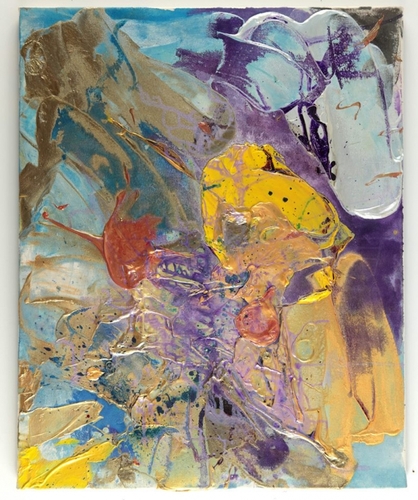BRATTLEBORO — Being the painter daughter of one of the prime movers of the post-war New York art scene during the 1960s and 1970s is not an easy position in which to find oneself.
Lauren Olitski's father, the late Jules Olitski, known mainly for his minimalist colorfield paintings, has maintained an important place in our nation's history of modern art. Comparisons would be inevitable.
While the elder Olitski was reluctant to give advice - he wished his daughter, who graduated from Sarah Lawrence, to find her own way - she says she got a lot from overhearing conversations between her father and his artist friends while growing up and just “seeing the work.”
Important pieces of advice she absorbed: find your colors, “don't just go with color right out of the tube,” says Olitski, who lives in Marlboro.
“He said to learn about color values from the old masters, who kept their values close, but would be willing to throw (the rules) out. He would encourage my experimenting. He also talked a lot about structure, and I listened to that,” Olitski said.
“My interpretation of what he meant was to study the Old Masters. The great paintings have a strong structure. You need that - the skeleton to hold the flesh.”
* * *
It would be many years before the daughter of one of the seminal abstract painters of New York's “second wave” attempted abstraction herself.
“I was always attracted to abstraction, but I didn't dare go there,” she says. And so she concentrated on figure and landscape painting.
But her father, in a roundabout way, was a motivator for her change. “For a time in the '90s, my father stopped painting abstracts altogether and started getting into landscapes and figures,” Olitski says, musing with a wry smile that perhaps he was moved to do so by her work at that time.
“I missed the abstracts!” she says, “and so I started to paint them. I discovered that I was very comfortable in that territory.”
While she still occasionally paints figuratively (landscapes and nudes), her show at Mitchell-Giddings Fine Art consists entirely of abstracts in acrylics, ranging in size from 20” x 16” to 84” x 60.”
Working flat, “mostly wet on wet,” she paints a thin stain ground, then builds up texture, pouring paint, moving it around, sometimes waiting a week or two before going back into it.
While Olitski's abstractions from some years back were surface-heavy, hard to see past the seductive swirls and globs, the new work feels more deeply rooted. The generous gesture and impasto is still present, with an almost choreographic laying on of paint, but the build-up of tonality and texture gives the artist's recent work a new richness. There is a push and pull that is very satisfying.
In works such as “30,” one of my favorites in the show, or “Loose Toulouse,” craters and swirling paint, texture, and lines of thin, long drips create splendid dramas on the canvas. One feels witness to an exotic cosmological event, an exploding nebula, or hurled to a distant planet, descending through gaseous clouds of otherworldly and unknown compounds.
Yet there is also an earthiness. There is intense textural working of the surface that is literally gritty in some places, an effect that Olitski accomplishes through a gel medium impregnated with pumice. It is mixed with acrylic paint and applied as thick impasto in some places, thinly in others. Several paintings, “30” being one, use this effect with great success.
Canvases might also have embedded bits of “stuff” that is lying on her studio table - anything is fair game.
Torn and crumpled wrappers, dried bits of acrylic paint, or plain gel medium left to dry and peeled away all may be collaged into the work.
In Olitski's figurative paintings, line is sometimes achieved by laying torn canvas strips and threads into the paint.
I ask her how she feels about figures that might appear inadvertently as she works, something that some abstract painters encourage.
“If I were to see a face or something figurative like a tree, it would drive me crazy,” Olitski says. “It's all I would see! It takes away from the power of the painting.”
* * *
As I look at the paintings with Olitski and comment on their inventiveness, another bit of her father's advice surfaces.
“He would often say, 'Don't forget to play. Allow yourself to make mistakes, don't hold yourself back,'” she says. “Those were important words for me.”
Olitski is carving a place for herself in the current art world, one in which there is not an ascendant approach to painting, or in fact any of the visual arts, where pretty much anything goes if it has enough conviction and guts behind it, where just a short while back painting was supposed to be dead.
Not so fast. Here is an artist for whom paint as paint (not as a medium to depict the seen world) has found a new vitality.
Olitski's approach to the medium is sensuous, joyous, and charged with an almost jazz-riff verve.
